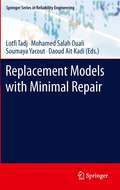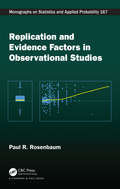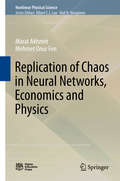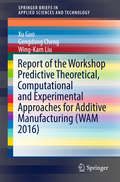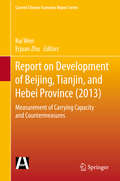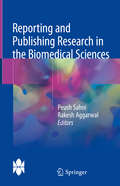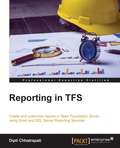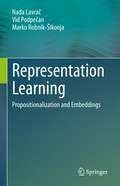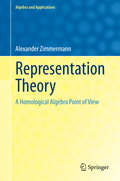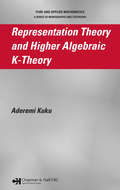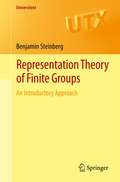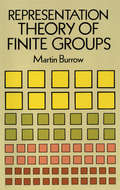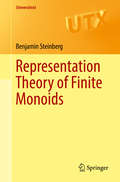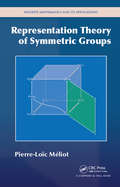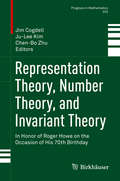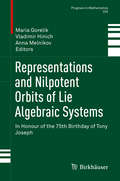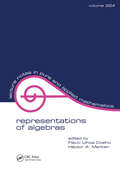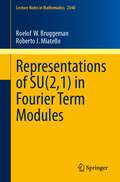- Table View
- List View
Replacement Models with Minimal Repair
by M. Salah Ouali Lotfi Tadj Soumaya Yacout Daoud Ait-KadiReplacement Models with Minimal Repair is a collection of works by several well-known specialists on the subject of minimal repair in replacement policies. It gives an exhaustive list of minimal repair models for the effective planning of minimal repair and maintenance actions. Written in an engaging style, Replacement Models with Minimal Repair balances complex mathematical models with practical applications. It is divided into six parts that cover: mathematical modeling of minimal repair;preventive maintenance models and optimal scheduling of imperfect preventive maintenance activities;a new warranty servicing strategy with imperfect repair;mathematical models combining burn-in procedure and general maintenance policies;methods for parameters' estimation of minimal repair models; andproduct support.Replacement Models with Minimal Repair is for anyone with an interest in minimal repair and its impact on maintenance policies and strategies. It is a particularly useful resource for researchers, practitioners, and graduate students.
Replication and Evidence Factors in Observational Studies (Chapman & Hall/CRC Monographs on Statistics and Applied Probability)
by Paul RosenbaumOutside of randomized experiments, association does not imply causation, and yet there is nothing defective about our knowledge that smoking causes lung cancer, a conclusion reached in the absence of randomized experimentation with humans. How is that possible? If observed associations do not identify causal effects in observational studies, how can a sequence of such associations become decisive? Two or more associations may each be susceptible to unmeasured biases, yet not susceptible to the same biases. An observational study has two evidence factors if it provides two comparisons susceptible to different biases that may be combined as if from independent studies of different data by different investigators, despite using the same data twice. If the two factors concur, then they may exhibit greater insensitivity to unmeasured biases than either factor exhibits on its own. Replication and Evidence Factors in Observational Studies includes four parts: A concise introduction to causal inference, making the book self-contained Practical examples of evidence factors from the health and social sciences with analyses in R The theory of evidence factors Study design with evidence factors A companion R package evident is available from CRAN.
Replication of Chaos in Neural Networks, Economics and Physics
by Marat Akhmet Mehmet Onur FenThis book presents detailed descriptions of chaos for continuous-time systems. It is the first-ever book to consider chaos as an input for differential and hybrid equations. Chaotic sets and chaotic functions are used as inputs for systems with attractors: equilibrium points, cycles and tori. The findings strongly suggest that chaos theory can proceed from the theory of differential equations to a higher level than previously thought. The approach selected is conducive to the in-depth analysis of different types of chaos. The appearance of deterministic chaos in neural networks, economics and mechanical systems is discussed theoretically and supported by simulations. As such, the book offers a valuable resource for mathematicians, physicists, engineers and economists studying nonlinear chaotic dynamics.
Report of the Workshop Predictive Theoretical, Computational and Experimental Approaches for Additive Manufacturing (WAM #2016)
by Xu Guo Gengdong Cheng Wing-Kam LiuThe volume focuses on theoretical and computational approaches and involves areas such as simulation-based engineering and science, integrated computational materials engineering, mechanics, material science, manufacturing processes, and other specialized areas. Most importantly, the state-of-the-art progress in developing predictive theoretical, computational and experimental approaches for additive manufacturing is summarized.
Report on Development of Beijing, Tianjin, and Hebei Province
by Kui Wen Erjuan ZhuThis book mainly focuses on the status, trends and countermeasures of carrying capacity in the Beijing-Tianjin-Hebei metropolitan region. It presents the results a comprehensive survey and systematic research on the carrying capacity of this region and its mega-cities, conducted in the hope of providing decision-making support for the governments of this region. The primary goals are to be able to actively respond to the new challenges of global climate changes and environmental resource constraints; fully practice green development concepts; and actively promote transformation in the development of the population, resources, environment, economics, society and ecology in this region.
Reporting and Publishing Research in the Biomedical Sciences: Revised Edition
by Peush Sahni Rakesh AggarwalThis book eases the task of converting research work into a manuscript, and covers the recent developments in publishing that often stump budding researchers.Few researchers in the biomedical sciences are trained in the essential skills of reporting their results, and they seek help in writing a paper that will be acceptable for publication in the ‘right’ journal, and in presenting their results ‘effectively’ at a meeting. As well as covering the basic aspects of preparing manuscripts for publication, the book discusses best practices and issues relating to the publication of biomedical research, including topics such as peer-review, authorship, plagiarism, conflicts of interest, publication misconduct, electronic publishing and open-access journals. With more than two decades of experience in conducting workshops on writing scientific papers, the editors have brought together the expertise of 29 authors from seven countries to produce this one-stop guide to publishing research in biomedical sciences. This book is intended for young researchers who are beginning their careers and wish to hone their skills and understand the rigors of research writing and publishing.
Reporting in TFS
by Dipti ChhatrapatiThis book is intended for developers, testers, architects, and project managers who want to explore and make use of the reporting facilities of Team Foundation Server 2013. Although no previous experience of reporting is required, a basic understanding of the Team Foundation Components and project templates would be a plus.
Representation Learning: Propositionalization and Embeddings
by Nada Lavrač Vid Podpečan Marko Robnik-ŠikonjaThis monograph addresses advances in representation learning, a cutting-edge research area of machine learning. Representation learning refers to modern data transformation techniques that convert data of different modalities and complexity, including texts, graphs, and relations, into compact tabular representations, which effectively capture their semantic properties and relations. The monograph focuses on (i) propositionalization approaches, established in relational learning and inductive logic programming, and (ii) embedding approaches, which have gained popularity with recent advances in deep learning. The authors establish a unifying perspective on representation learning techniques developed in these various areas of modern data science, enabling the reader to understand the common underlying principles and to gain insight using selected examples and sample Python code. The monograph should be of interest to a wide audience, ranging from data scientists, machine learning researchers and students to developers, software engineers and industrial researchers interested in hands-on AI solutions.
Representation Theory
by Alexander ZimmermannIntroducing the representation theory of groups and finite dimensional algebras, first studying basic non-commutative ring theory, this book covers the necessary background on elementary homological algebra and representations of groups up to block theory. It further discusses vertices, defect groups, Green and Brauer correspondences and Clifford theory. Whenever possible the statements are presented in a general setting for more general algebras, such as symmetric finite dimensional algebras over a field. Then, abelian and derived categories are introduced in detail and are used to explain stable module categories, as well as derived categories and their main invariants and links between them. Group theoretical applications of these theories are given - such as the structure of blocks of cyclic defect groups - whenever appropriate. Overall, many methods from the representation theory of algebras are introduced. Representation Theory assumes only the most basic knowledge of linear algebra, groups, rings and fields and guides the reader in the use of categorical equivalences in the representation theory of groups and algebras. As the book is based on lectures, it will be accessible to any graduate student in algebra and can be used for self-study as well as for classroom use.
Representation Theory and Harmonic Analysis of Wreath Products of Finite Groups
by CeccheriniThis book presents an introduction to the representation theory of wreath products of finite groups and harmonic analysis on the corresponding homogeneous spaces. The reader will find a detailed description of the theory of induced representations and Clifford theory, focusing on a general formulation of the little group method. This provides essential tools for the determination of all irreducible representations of wreath products of finite groups. The exposition also includes a detailed harmonic analysis of the finite lamplighter groups, the hyperoctahedral groups, and the wreath product of two symmetric groups. This relies on the generalised Johnson scheme, a new construction of finite Gelfand pairs. The exposition is completely self-contained and accessible to anyone with a basic knowledge of representation theory. Plenty of worked examples and several exercises are provided, making this volume an ideal textbook for graduate students. It also represents a useful reference for more experienced researchers.
Representation Theory and Higher Algebraic K-Theory
by Aderemi KukuRepresentation Theory and Higher Algebraic K-Theory is the first book to present higher algebraic K-theory of orders and group rings as well as characterize higher algebraic K-theory as Mackey functors that lead to equivariant higher algebraic K-theory and their relative generalizations. Thus, this book makes computations of higher K-theory of grou
Representation Theory of Finite Groups
by Benjamin SteinbergThis book is intended to present group representation theory at a level accessible to mature undergraduate students and beginning graduate students. This is achieved by mainly keeping the required background to the level of undergraduate linear algebra, group theory and very basic ring theory. Module theory and Wedderburn theory, as well as tensor products, are deliberately avoided. Instead, we take an approach based on discrete Fourier Analysis. Applications to the spectral theory of graphs are given to help the student appreciate the usefulness of the subject. A number of exercises are included. This book is intended for a 3rd/4th undergraduate course or an introductory graduate course on group representation theory. However, it can also be used as a reference for workers in all areas of mathematics and statistics.
Representation Theory of Finite Groups
by Martin BurrowConcise, graduate-level exposition of the theory of finite groups, including the theory of modular representations. Topics include representation theory of rings with identity, representation theory of finite groups, applications of the theory of characters, construction of irreducible representations and modular representations. Rudiments of linear algebra and knowledge of group theory helpful prerequisites. Exercises. Bibliography. Appendix. 1965 edition.
Representation Theory of Finite Monoids
by Benjamin SteinbergThis first text on the subject provides a comprehensive introduction to the representation theory of finite monoids. Carefully worked examples and exercises provide the bells and whistles for graduate accessibility, bringing a broad range of advanced readers to the forefront of research in the area. Highlights of the text include applications to probability theory, symbolic dynamics, and automata theory. Comfort with module theory, a familiarity with ordinary group representation theory, and the basics of Wedderburn theory, are prerequisites for advanced graduate level study. Researchers in algebra, algebraic combinatorics, automata theory, and probability theory, will find this text enriching with its thorough presentation of applications of the theory to these fields. Prior knowledge of semigroup theory is not expected for the diverse readership that may benefit from this exposition. The approach taken in this book is highly module-theoretic and follows the modern flavor of the theory of finite dimensional algebras. The content is divided into 7 parts. Part I consists of 3 preliminary chapters with no prior knowledge beyond group theory assumed. Part II forms the core of the material giving a modern module-theoretic treatment of the Clifford -Munn-Ponizovskii theory of irreducible representations. Part III concerns character theory and the character table of a monoid. Part IV is devoted to the representation theory of inverse monoids and categories and Part V presents the theory of the Rhodes radical with applications to triangularizability. Part VI features 3 chapters devoted to applications to diverse areas of mathematics and forms a high point of the text. The last part, Part VII, is concerned with advanced topics. There are also 3 appendices reviewing finite dimensional algebras, group representation theory, and M#65533;bius inversion.
Representation Theory of Symmetric Groups (Discrete Mathematics and Its Applications)
by Pierre-Loic MeliotRepresentation Theory of Symmetric Groups is the most up-to-date abstract algebra book on the subject of symmetric groups and representation theory. Utilizing new research and results, this book can be studied from a combinatorial, algorithmic or algebraic viewpoint. This book is an excellent way of introducing today’s students to representation theory of the symmetric groups, namely classical theory. From there, the book explains how the theory can be extended to other related combinatorial algebras like the Iwahori-Hecke algebra. In a clear and concise manner, the author presents the case that most calculations on symmetric group can be performed by utilizing appropriate algebras of functions. Thus, the book explains how some Hopf algebras (symmetric functions and generalizations) can be used to encode most of the combinatorial properties of the representations of symmetric groups. Overall, the book is an innovative introduction to representation theory of symmetric groups for graduate students and researchers seeking new ways of thought.
Representation Theory of the Symmetric Groups
by Tullio Ceccherini-Silberstein Fabio Scarabotti Filippo TolliA self-contained introduction to the representation theory of the symmetric groups, including an exhaustive exposition of the Okounkov Vershik approach.
Representation Theory, Number Theory, and Invariant Theory: In Honor Of Roger Howe On The Occasion Of His 70th Birthday (Progress In Mathematics Ser. #323)
by Jim Cogdell Ju-Lee Kim Chen-Bo ZhuThis book contains selected papers based on talks given at the "Representation Theory, Number Theory, and Invariant Theory" conference held at Yale University from June 1 to June 5, 2015. The meeting and this resulting volume are in honor of Professor Roger Howe, on the occasion of his 70th birthday, whose work and insights have been deeply influential in the development of these fields. The speakers who contributed to this work include Roger Howe's doctoral students, Roger Howe himself, and other world renowned mathematicians. Topics covered include automorphic forms, invariant theory, representation theory of reductive groups over local fields, and related subjects.
Representations and Characters of Groups
by Gordon James Martin LiebeckThis is the second edition of the popular textbook on representation theory of finite groups. The authors have revised the text greatly and included new chapters on Characters of GL(2,q) and Permutations and Characters. The theory is developed in terms of modules, since this is appropriate for more advanced work, but considerable emphasis is placed upon constructing characters. The character tables of many groups are given, including all groups of order less than 32, and all but one of the simple groups of order less than 1000. Each chapter is accompanied by a variety of exercises, and full solutions to all the exercises are provided at the end of the book.
Representations and Nilpotent Orbits of Lie Algebraic Systems: In Honour of the 75th Birthday of Tony Joseph (Progress in Mathematics #330)
by Anna Melnikov Maria Gorelik Vladimir HinichThis volume, a celebration of Anthony Joseph’s fundamental influence on classical and quantized representation theory, explores a wide array of current topics in Lie theory by experts in the area. The chapters are based on the 2017 sister conferences titled “Algebraic Modes of Representations,” the first of which was held from July 16-18 at the Weizmann Institute of Science and the second from July 19-23 at the University of Haifa. The chapters in this volume cover a range of topics, including:Primitive idealsInvariant theoryGeometry of Lie group actionsQuantum affine algebrasYangiansCategorificationVertex algebrasThis volume is addressed to mathematicians who specialize in representation theory and Lie theory, and who wish to learn more about this fascinating subject.
Representations of Algebras
by Flávio Ulhoa Coelho Héctor A. MerklenThis volume contains the proceedings of the Conference on Representations of Algebras - Sao Paulo (CRASP), held at the Instituto de Matematica e Estatistica of the Universidade de Sao Paulo, Brazil. It discusses Hopf, tubular, quasischurian, wild hereditary, concealed-canonical Artin, Brauer star, and Koszul algebras.
Representations of Elementary Abelian p-Groups and Vector Bundles
by David J. BensonQuestions about modular representation theory of finite groups can often be reduced to elementary abelian subgroups. This is the first book to offer a detailed study of the representation theory of elementary abelian groups, bringing together information from many papers and journals, as well as unpublished research. Special attention is given to recent work on modules of constant Jordan type, and the methods involve producing and examining vector bundles on projective space and their Chern classes. Extensive background material is provided, which will help the reader to understand vector bundles and their Chern classes from an algebraic point of view, and to apply this to modular representation theory of elementary abelian groups. The final section, addressing problems and directions for future research, will also help to stimulate further developments in the subject. With no similar books on the market, this will be an invaluable resource for graduate students and researchers working in representation theory.
Representations of Finite Groups of Lie Type (London Mathematical Society Student Texts #95)
by François Digne Jean MichelOn its original publication, this book provided the first elementary treatment of representation theory of finite groups of Lie type in book form. This second edition features new material to reflect the continuous evolution of the subject, including entirely new chapters on Hecke algebras, Green functions and Lusztig families. The authors cover the basic theory of representations of finite groups of Lie type, such as linear, unitary, orthogonal and symplectic groups. They emphasise the Curtis–Alvis duality map and Mackey's theorem and the results that can be deduced from it, before moving on to a discussion of Deligne–Lusztig induction and Lusztig's Jordan decomposition theorem for characters. The book contains the background information needed to make it a useful resource for beginning graduate students in algebra as well as seasoned researchers. It includes exercises and explicit examples.
Representations of Lie Algebras
by Anthony HendersonThis bold and refreshing approach to Lie algebras assumes only modest prerequisites (linear algebra up to the Jordan canonical form and a basic familiarity with groups and rings), yet it reaches a major result in representation theory: the highest-weight classification of irreducible modules of the general linear Lie algebra. The author's exposition is focused on this goal rather than aiming at the widest generality and emphasis is placed on explicit calculations with bases and matrices. The book begins with a motivating chapter explaining the context and relevance of Lie algebras and their representations and concludes with a guide to further reading. Numerous examples and exercises with full solutions are included. Based on the author's own introductory course on Lie algebras, this book has been thoroughly road-tested by advanced undergraduate and beginning graduate students and it is also suited to individual readers wanting an introduction to this important area of mathematics.
Representations of SU (Lecture Notes in Mathematics #2340)
by Roelof W. Bruggeman Roberto J. MiatelloThis book studies the modules arising in Fourier expansions of automorphic forms, namely Fourier term modules on SU(2,1), the smallest rank one Lie group with a non-abelian unipotent subgroup. It considers the “abelian” Fourier term modules connected to characters of the maximal unipotent subgroups of SU(2,1), and also the “non-abelian” modules, described via theta functions. A complete description of the submodule structure of all Fourier term modules is given, with a discussion of the consequences for Fourier expansions of automorphic forms, automorphic forms with exponential growth included.These results can be applied to prove a completeness result for Poincaré series in spaces of square integrable automorphic forms.Aimed at researchers and graduate students interested in automorphic forms, harmonic analysis on Lie groups, and number-theoretic topics related to Poincaré series, the book will also serve as a basic reference on spectral expansion with Fourier-Jacobi coefficients. Only a background in Lie groups and their representations is assumed.
Representations of Solvable Lie Groups: Basic Theory and Examples (New Mathematical Monographs #39)
by Didier Arnal Bradley CurreyThe theory of unitary group representations began with finite groups, and blossomed in the twentieth century both as a natural abstraction of classical harmonic analysis, and as a tool for understanding various physical phenomena. Combining basic theory and new results, this monograph is a fresh and self-contained exposition of group representations and harmonic analysis on solvable Lie groups. Covering a range of topics from stratification methods for linear solvable actions in a finite-dimensional vector space, to complete proofs of essential elements of Mackey theory and a unified development of the main features of the orbit method for solvable Lie groups, the authors provide both well-known and new examples, with a focus on those relevant to contemporary applications. Clear explanations of the basic theory make this an invaluable reference guide for graduate students as well as researchers.
